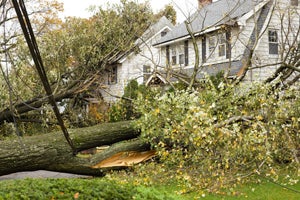Stay protected during high winds
Yes
High wind safety tips and resources for individuals
High winds can be dangerous and are capable of causing significant damage and disruption. Powerful gusts can uproot trees, damage roofs and send debris flying, causing property damage and power outages. We are here to help should you need to file a claim.
Here are some tips to help you prepare for the wind and keep your family and property safe.
Prepare today
- Perform regular property maintenance – Care for trees and shrubs near your home to reduce the risk of debris damage during high winds.
- Remove or cut back dead and dying trees to help prevent potential hazards and improve the safety of your property.
Before the storm
- Shut doors and tape windows and glass doors. Use storm shutters or plywood nailed to window frames to protect windows.
- Close all interior doors to help reduce wind damage.
- Move items inside (bikes, furniture) as they may blow around during the storm and cause damage. Do not store gas-powered articles inside your home; secure them outside.
- Fill your car and generator with gas and keep extra fuel handy in approved containers and in a safe location.
- Park your car in the garage.
- Prepare your emergency kit and emergency plan.
What is a high wind warning?
A high wind warning is issued when sustained winds reach or exceed 40 mph for an hour or longer, or when wind gusts reach or exceed 58 mph for any duration.
During the storm
- Stay indoors and keep away from windows. Move to an interior room if possible.
- Listen to weather updates. Have a battery-operated radio handy in the event of a power outage.
- Wait to go outside until there is confirmation that high winds are no longer a threat to your area.
- Keep your refrigerator doors closed to keep food as cold as possible and prevent thawing in case the power goes out.
After the storm
- Inspect gas, electrical and water lines for damage. Look for structural damage such as foundation cracks.
- Document any property damage with photos and videos and save receipts for immediate repairs made to prevent further damage.
- Stay out of damaged buildings until it is safe to do so.
- Avoid touching power lines and assume all downed power lines are live.
- Log all post-event clean-up efforts and expenses.
- If there is flooding:
- Clean up pools of water.
- Dry damp areas to prevent mold and mildew.
- Move damp items outdoors when safe to prevent mold growth.
- Move items away from damp areas.
Be sure to notify our claims team immediately if there is damage and protect the property while mitigating any future risk.
SOURCES:



